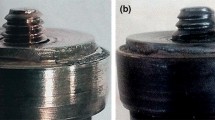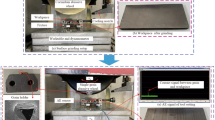Abstract
In order to improve the performance of metal-bonded grinding wheels, the graphite particles with several different contents (i.e., 5, 10, 15, and 20 wt%) were added to Cu-Sn-Ti alloy powders as the bonding materials. The influence of graphite addition on bonding properties of the abrasive layer was investigated. Firstly, microstructural examination results show that the joining between graphite and Cu-Sn-Ti alloy was achieved and provided a weak bonding strength compared to the pure Cu-Sn-Ti matrix. Secondly, the transgranular fracture and intergranular fracture were determined as the main fracture patterns of abrasive layer in the current investigation. Then, an optimized graphite content of 10 wt% was decided, at which the porosity of abrasive layer can reach 25% as well as the bending strength reached 125 MPa and was favorable to meet the high-speed grinding requirements. Finally, the finite element simulation results suggested that the graphite addition had little effect on the residual thermal stresses of abrasive layer.
Similar content being viewed by others
References
Dambatta YS, Sarhan AAD, Sayuti M, Hamdi M (2017) Ultrasonic assisted grinding of advanced materials for biomedical and aerospace applications—a review. Int J Adv Manuf Technol. doi:10.1007/s00170-017-0316-z
Zhang ZY, Huo YX, Guo DM (2013) A model for nanogrinding based on direct evidence of ground chips of silicon wafers. Sci China Technol Sci 56:2099–2108
Yu TY, Asplund DT, Bastawros AF, Chandra A (2016) Performance and modeling of paired polishing process. Int J Mach Tools Manuf 109:49–57
An QL, Fu YC, Xu JH (2010) A new technology on enhancing heat transfer during grinding of titanium alloy. Ind Lubr Tribol 62:168–173
Brinksmeier E, Mutlugunes Y, Klocke F, Aurich JC, Shore P, Ohmori H (2010) Ultra-precision grinding. CIRP Ann Manuf Technol 59:652–671
Guo C, Ranganath S, McIntosh D, Elfizy A (2008) Virtual high performance grinding with CBN wheels. CIRP Ann Manuf Technol 57:325–328
Kawagoishi N, Chen Q, Kondo E, Goto M, Nisitani H (1999) Influence of cubic boron nitride grinding on the fatigue strengths of carbon steels and a nickel-base superalloy. J Mater Eng Perform 8:152–158
Vashista M, Kumar S, Ghosh A, Paul S (2010) Surface integrity in grinding medium carbon steel with miniature electroplated monolayer cBN wheel. J Mater Eng Perform 19:1248–1255
Winter M, Ibbotson S, Kara S, Herrmann C (2015) Life cycle assessment of cubic boron nitride grinding wheels. J Clean Prod 107:707–721
Zhang ZY, Guo DM, Kang RK, Gao H, Jin ZJ, Meng YW (2010) Subsurface crystal lattice deformation machined by ultraprecision grinding of soft-brittle CdZnTe crystals. Int J Adv Manuf Technol 47:1065–1081
Herman D, Krzos J (2009) Influence of vitrified bond structure on radial wear of cBN grinding wheels. J Mater Process Technol 209:5377–5386
Jackson MJ, Davis CJ, Hitchiner MP, Mills B (2011) High-speed grinding with CBN grinding wheels—applications and future technology. J Mater Process Technol 110:78–88
Yu TY, Bastawros AF, Chandra A (2015) Modeling wear process of electroplated CBN grinding wheel. In: Proceedings of the ASME 2015 International Manufacturing Science and Engineering Conference, Jun. 8–12; Charlotte: 1–7
Ghosh A, Chattopadhyay AK (2007) On grain-failure of an indigenously developed single layer brazed CBN wheel. Ind Diam Rev 1:59–64
Bhaskar P, Chattopadhyay AK, Chattopadhyay AB (2010) Development and performance evaluation of monolayer brazed cBN grinding wheel on bearing steel. Int J Adv Manuf Technol 48:935–944
Linke BS (2015) Review on grinding tool wear with regard to sustainability. ASME J Manuf Sci Eng 137:060801–060802
Beyer P (2005) High-production grinding with vitrified bond superabrasives-HPB technology for vitrified bond CBN wheels. Ind Diam Rev 1:46–58
Denkena B, Preising D, Woiwode S (2015) Gear profile grinding with metal bonded CBN tools. Prod Eng Res Dev 9:73–77
Klocke F, Klink A (2007) Electrochemical oxidation analysis for dressing bronze-bonded diamond grinding wheels. Prod Eng Res Dev 1:141–148
Denkena B, Kohler J, Seiffert F (2011) Machining of reinforced concrete using grinding wheels with defined grain pattern. Int J Abras Technol 4:101–116
Kopac J, Krajnik P (2006) High-performance grinding—a review. J Mater Process Technol 175:278–284
Walter C, Rabiey M, Warhanek M, Jochum N, Wegener K (2012) Dressing and truing of hybrid bonded CBN grinding tools using a short-pulsed fibre laser. CIRP Ann Manuf Technol 61:279–282
Shaji S, Radhakrishnan V (2003) Application of solid lubricants in grinding: investigations of graphite sandwiched grinding wheels. Mach Sci Technol 7:137–155
Reddy NSK, Rao PV (2006) Experimental investigation to study the effect of solid lubricants on cutting forces and surface quality in end milling. Int J Mach Tools Manuf 46:189–198
Denkena B, Grove T, Bremer I, Behrens L (2016) Design of bronze-bonded grinding wheel properties. CIRP Ann Manuf Technol 65:333–336
Ding WF, Xu JH, Chen ZZ, Miao Q, Yang CY (2013) Interface characteristics and fracture behavior of brazed polycrystalline CBN grains using Cu-Sn-Ti alloy. Mater Sci Eng A 559:629–634
Miao Q, Ding WF, Zhu YJ, Chen ZZ, Fu YC (2016) Brazing of CBN grains with Ag-Cu-Ti/TiX composite filler-the effect of TiX particles on microstructure and strength of bonding layer. Mater Des 98:243–253
Wang TP, Ivas T, Leinenbach C, Zhang J (2015) Microstructural characterization of Si3N4/42CrMo joints brazed with Ag-Cu-Ti+TiNp composite filler. J Alloys Compd 651:623–630
Shaji S, Radhakrishnan V (2003) An investigation on solid lubricant moulded grinding wheels. Int J Mach Tools Manuf 43:965–972
Tsai MY, Jian SX (2012) Development of a micro-graphite impregnated grinding wheel. Int J Mach Tools Manuf 56:94–101
Ma CY, Ding WF, Xu JH, Fu YC (2015) Influence of alumina bubble particles on microstructure and mechanical strength in porous Cu-Sn-Ti metals. Mater Des 65:50–56
Mao JB, Zhang FL, Liao GC, Zhou YM, Huang HP, Wang CY, Wu SH (2014) Effect of granulated sugar as pore former on the microstructure and mechanical properties of the vitrified bond cubic boron nitride grinding wheels. Mater Des 60:328–333
Alberts M, Kalaitzidou K, Melkote S (2009) An investigation of graphite nanoplatelets as lubricant in grinding. Int J Mach Tools Manuf 49:966–970
Zhang XP, Li CH, Zhang YB, Jia DZ, Li BK, Wang YG, Yang M, Hou YL, Zhang XW (2016) Performances of Al2O3/SiC hybrid nanofluids in minimum-quantity lubrication grinding. Int J Adv Manuf Technol 86:3427–3441
Mao C, Zhou X, Yin LR, Zhang MJ, Tang K, Zhang J (2016) Investigation of the flow field for a double-outlet nozzle during minimum quantity lubrication grinding. Int J Adv Manuf Technol 85:291–298
Mao C, Huang Y, Zhou X, Gan H, Zhang J, Zhou ZX (2014) The tribological properties of nanofluid used in minimum quantity lubrication grinding. Int J Adv Manuf Technol 71:1221–1228
Hsieh YC, Lin ST (2008) Microstructural development of Cu-Sn-Ti alloys on graphite. J Alloys Compd 466:126–132
Wang Y, Qiu XM, Sun DQ, Yin SQ (2011) Influence of Ti on microstructure and strength of c-BN/Cu-Ni-Sn-Ti composites. Int J Refract Met Hard Mater 29:293–297
Shiue RK, Wu SK, Chan CH (2004) The interfacial reactions of infrared brazing Cu and Ti with two silver-based brazed alloys. J Alloys Compd 372:148–157
Ding WF, Miao Q, Xu JH, Chen ZZ, Yang CY, Fu YC (2013) Preparation mechanism and grinding performance of single-layer self-lubrication brazed CBN abrasive wheels. Int J Adv Manuf Technol 68:249–255
Lin CC, Chen RB, Shiue EK (2001) A wettability study of Cu/Sn/Ti active braze alloys on alumina. J Mater Sci 36:2145–2150
Passerone A, Valenza F, Muolo ML (2012) A review of transition metals diborides: from wettability studies to joining. J Mater Sci 47:8275–8289
Hausner S, Wielage B (2013) Brazing of metal and ceramic joints. Woodhead Publishing Limited, Germany
Halbig MC, Coddingto BP, Asthana R, Singh M (2013) Characterization of silicon carbide joints fabricated using SiC particulate-reinforced Ag-Cu-Ti alloys. Ceram Int 39:4151–4162
Zhu YJ, Ding WF, Xu JH, Yang CY (2015) An investigation of residual stresses in brazed cubic boron nitride abrasive grains by finite element modelling and Raman spectroscopy. Mater Des 87:342–351
Devincent SM, Michal GM (1993) Improvement of thermal and mechanical properties of graphite/copper composites through interfacial modification. J Mater Eng Perform 2:323–332
Wang ZF, Qi R, Wang J, Qi SH (2015) Thermal conductivity improvement of epoxy composite filled with expanded graphite. Ceram Int 41:13541–13546
Cao YT, Yan JZ, Li N, Zeng Y, Xin CL (2015) Effects of brazing temperature on microstructure and mechanical performance of Al2O3/AgCuTi/Fe-Ni-Co brazed joints. J Alloys Compd 650:30–36
Hilders O, Pena ND, Ramos M, Saenz L, Berrio L, Caballero RA, Quintero A (2002) Stress triaxiality dimple fracture morphology and fractal dimension relations for several aluminum alloys. Mater Sci Forum 396-402:1321–1328
Ding WF, Zhu YZ, Zhang LC, Xu JH, Fu YC, Liu WD, Yang CY (2015) Stress characteristics and fracture wear of brazed CBN grains in monolayer grinding wheels. Wear 332–333:800–809
Shen B, Chen SL, Chen YS, Sun FH (2017) Enhancement on the tribological performance of diamond films by utilizing graphene coating as a solid lubricant. Surf Coat Technol 311:35–45
Li XS, Zhang JQ (2011) Research on key manufacturing technologies for super-high speed vitrified bond CBN grinding wheel. Tool Eng 45:3–7
Zhang JQ, Pang ZR, Yu TB, Wang WS (2011) Experiment study based on nano-ceramic grinding wheel bond. Adv Mater Res 299–300:250–254
Miab RJ, Hadian AM (2014) Effect of brazing time on microstructure and mechanical properties of cubic boron nitride/steel joints. Ceram Int 40:8519–8524
Wang TP, Lvas T, Lee W, Leinenbach C, Zhang J (2016) Relief of the residual stresses in Si3N4/Invar joints by multi-layered braze structure-experiments and simulation. Ceram Int 42:7080–7087
Qiu HP, Guo QG, Song YZ, Zhai GT, Song JR, Liu L (2002) Study of the relationship between thermal conductivity and microcrystalline parameters of buck graphite. New Carbon Mater 17:36–40
Author information
Authors and Affiliations
Corresponding author
Rights and permissions
About this article
Cite this article
Miao, Q., Ding, W., Fu, D. et al. Influence of graphite addition on bonding properties of abrasive layer of metal-bonded CBN wheel. Int J Adv Manuf Technol 93, 2675–2684 (2017). https://doi.org/10.1007/s00170-017-0714-2
Received:
Accepted:
Published:
Issue Date:
DOI: https://doi.org/10.1007/s00170-017-0714-2




